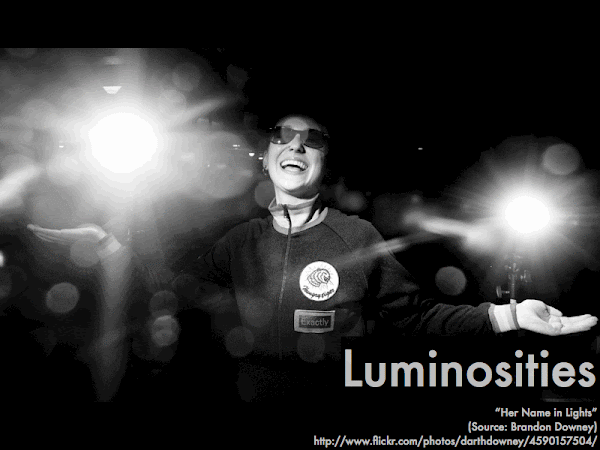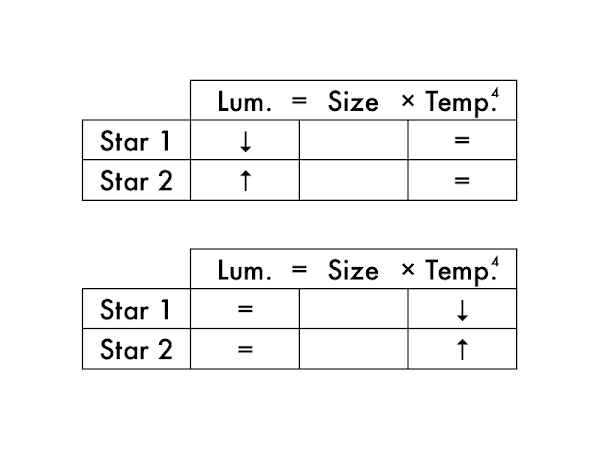Cuesta College, San Luis Obispo, CA
Students have a weekly online reading assignment (hosted by SurveyMonkey.com), where they answer questions based on reading their textbook, material covered in previous lectures, opinion questions, and/or asking (anonymous) questions or making (anonymous) comments. Full credit is given for completing the online reading assignment before next week's lecture, regardless if whether their answers are correct/incorrect. Selected results/questions/comments are addressed by the instructor at the start of the following lecture.
The following questions were asked on reading textbook chapters and previewing presentations on parallax, distance, apparent magnitude, absolute magnitude, Wien's law and the Stefan-Boltzmann law, and a TED-Ed talk on stellar properties.

Selected/edited responses are given below.
Describe something you found interesting from the assigned textbook reading or presentation preview, and explain why this was personally interesting for you.
"I never really knew how brightness was measured, and it was cool to learn about."
"That stars can be much, much brighter than the sun."
"The way we can measure distance of stars using parallax is crazy!"
"How simply by using color spectra and basic parallax (trigonometry) ideas, we can determine sizes, distances, and temperatures of very distant stars."
"How the hotter stars are a blue color while the coolest stars are red. I initially assumed that the red stars would be hotter as we associate the color red with hot things. Now I know differently!"
"In astronomy, temperature is a number that relates to the average speed of a particle. I found it interesting because it's not defined as the term we use often."
"I'm glad to learn about Wien's law (how color of stars relate to their temperature). When we took the general astronomy knowledge test on the first day of class, I was completely lost on this subject."
"I found learning about stars to be really interesting, especially being able to tell the stars temperature by their colors."
"When looking at Wien's law, I found it very interesting that extremely cool stars colder than red give off infrared light, while extremely hot stars will give off ultraviolet light. It's weird to imagine extremely cool stars being infrared and non-visible. This makes me wonder if all stars were a visible temperature, how much different would the night sky look?"
Describe something you found confusing from the assigned textbook reading or presentation preview, and explain why this was personally confusing for you.
"I found the magnitude scale a bit confusing at first because my brain didn't like the switch of high negative numbers defining the brightest stars and high positive numbers defining the dimmer stars."
"Parallax, stellar parallax, and parsecs are a confusing set of concepts for me to wrap my head around. It is difficult for me to understand a visual representation of parallax."
"The math in the two laws for blackbody radiation. Seeing some examples will help."
"I found that the Stefan-Boltzmann law was confusing because I'm not to sure what luminosity means. It just seems way more complex than Wien's law."
"Stefan-Boltzmann law. I don't understand it completely."
"This week's assignment had A LOT of new terms and ideas. Each individual idea is relatively easy to grasp given enough time to think about it. The problem, for me, was that there were just too many new things to take in and digest. I don't think I clearly understood most of this weeks reading. And for the first time, the blogs didn't really help understand the topic at hand; up until now they usually have."
Explain how apparent magnitude and the absolute magnitude are defined differently.
"Apparent magnitude is how bright a star looks from Earth and absolute magnitude is how bright the star from 32.6 light years (10 parsecs) away."
"Apparent magnitude is the brightness of a star 'as is' seen by an observer on Earth without the compensation for distance. The absolute magnitude of a star is its observed brightness when moved to the 'fair comparison distance' of 10 parsecs away. Absolute magnitude helps us compare the actual brightness of stars."
Suppose the sun was moved to a distance of 10 parsecs away. As a result, its __________ magnitude would become dimmer.
absolute. *********** [11] apparent. ************** [14] (Both of the above choices.) [0] (Neither of the above choices.) [0] (Unsure/guessing/lost/help!) * [1]

(Only correct responses shown.)
1 (brightest): the sun, m = –27 [96%]
2: Canopus, m = –1 [92%]
3: Vega, m = 0 [88%]
4 (dimmest): Kapteyn's star, m = +9 [92%]
Rank the brightnesses of these stars (1 = brightest, 4 = dimmest; there are no ties), if relocated to 10 parsecs from Earth.
(Only correct responses shown.)
1 (brightest): Canopus, M = –3 [88%]
2: Vega, M = +0.5 [92%]
3: the sun, M = +5 [88%]
4 (dimmest): Kapteyn's star, M = +11 [92%]
Determine whether these stars get dimmer or brighter when relocated from their original positions to 10 parsecs from Earth.
(Only correct responses shown.)
The sun: gets dimmer [88%]
Canopus: gets brighter [88%]
Vega: gets dimmer [58%]
Kapteyn's star: gets dimmer [62%]
Rank the temperatures of these main sequence stars (1 = hottest, 4 = coolest; there are no ties).
(Only correct responses shown.)
Hottest: blue main sequence star [85%]
Second hottest: white main sequence star [85%]
Third hottest: yellow main sequence star [92%]
Coolest: red main sequence star [85%]
Rank the temperatures of these supergiant and dwarf stars (1 = hottest, 4 = coolest; there are no ties).
(Only correct responses shown.)
Hottest: blue supergiant [96%]
Second hottest: white dwarf [73%]
Third hottest: yellow supergiant [69%]
Coolest: red dwarf [88%]

less luminous. **** [4] more luminous. ******************** [20] (These stars would be the same size.) * [1] (Unsure/guessing/lost/help!) * [1]
Two stars (equally far away) have the same brightness, but one star is cooler, and the other star is hotter. The __________ star will be larger in size.
cooler. ************* [13] hotter. ****** [6] (These stars would be the same size.) *** [3] (Unsure/guessing/lost/help!) **** [4]
Ask the instructor an anonymous question, or make a comment. Selected questions/comments may be discussed in class.
"Just a little more explanations for star brightnesses."
"Just little clarification questions."
"This might be off-topic, but how come nebulae are cloudy-looking?" (They literally are clouds, which are dust and gases randomly strewn out in space without any structure, unless affected by a shockwave if a star explodes nearby, or gravity if enough stuff starts to clump together inside the nebula.)
"Are stars' temperatures harder to measure the further away they are from Earth?" (As long as you can see the star's color, you'll know how hot it is.)
"What determines the how hot a star burns? I though they, at least, start off with the same fuel (hydrogen)." (We'll cover fusion and how quickly stars "burn" hydrogen next week.)
"The other night, I was able to show off my astronomy knowledge to my friends who had asked what AM and PM stood for. I was able to explain the ante-meridian and post-meridian concept, and it was cool having the ability to share with them the reasoning behind it!"
"Do we get extra credit if we go to see the SOFIA aircraft telescope?" (No, but good for you to get that chance this weekend. Also: pics, or it didn't happen.)
No comments:
Post a Comment